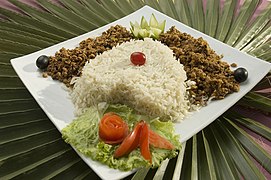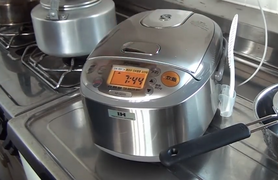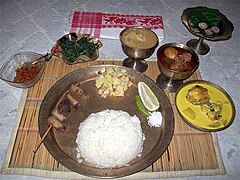Cooked rice
This article needs additional citations for verification. (November 2012) |
 A bowl of cooked white rice | |
| Main ingredients | rice, water |
|---|---|
| 85 kcal (356 kJ)[1] | |
| Similar dishes | bap, biryani, risotto |
Cooked rice refers to rice that has been cooked either by steaming or boiling. The terms steamed rice or boiled rice are also commonly used. Any variant of Asian rice (both Indica and Japonica varieties), African rice or wild rice, glutinous or non-glutinous, long-, medium-, or short-grain, of any colour, can be used. Rice for cooking can be whole grain or milled.
Cooked rice is used as a base for various fried rice dishes (e.g. chǎofàn, khao phat), rice bowls/plates (e.g. bibimbap, chazuke, curry rice, dal bhat, donburi, loco moco, panta bhat, rice and beans, rice and gravy), rice porridges (e.g. congee, juk), rice balls/rolls (e.g. gimbap, onigiri, sushi, zongzi), as well as rice cakes and desserts (e.g. mochi, tteok, yaksik).
Rice is a staple food in not only Asia and Latin America, but across the globe, and is the most consumed foodstuff in the world. The U.S. Department of Agriculture classifies rice as part of the grains food group. Nutritionally, 200 g of cooked steamed white rice contributes 60 g (2 oz) toward the daily recommended 170 and 200 g (6 and 7 oz) of grains for women and men, respectively, and is considered a good source of micronutrients such as zinc and manganese.[2]
Preparation
[edit]

Rice is often rinsed and soaked before being cooked. Unpolished brown rice requires longer soaking time than milled white rice does. The amount of water added can vary depending on many factors. In most cases, double water in proportion to rice is added depending on the variety of rice and the container it is contained, high cylindrical container is an example. Newly harvested rice usually requires less water,[3] and softer varieties need more water than firmer varieties.
Rice can be boiled in a heavy-bottomed cookware or steamed in a food steamer. Some boiling methods do not require precise water measurements, as the rice is strained after boiling.[4] This draining method is suitable for the less glutinous varieties such as basmati rice, but not-suitable for varieties like japonica rice which become sticky to some degree when cooked. Optionally, a small amount of salt can be added before cooking. If not drained, boiled rice is usually cooked on high heat until a rolling boil, then simmered with the lid on, and steamed over the residual heat after turning off the heat. Nowadays, electric rice cookers are also commonly used to cook rice. During cooking, rice absorbs water and increase in volume and mass.
Use in dishes
[edit]In East Asia, cooked rice is most commonly served in individual bowls, with each diner receiving one. Food from local dishes is placed upon the rice, and is then eaten.
Cooked or boiled rice is used as an ingredient in many dishes. Leftover steamed rice is used to make porridge or fried rice dishes. Some common dishes using cooked rice as the main ingredient include:
- Fried rice dishes
- Rice bowls and plates
- Rice porridges
- Rice balls and rolls
- Rice cakes and desserts
Use in beverages
[edit]- Alcoholic
- Non-alcoholic
Varieties
[edit]Most common is plain, steamed white rice; however, a number of varieties and are served, many with specific cooking methods. Some varieties include:
- Japonica rice
- Thai steamed rice
- Sticky rice
- Sushi rice (cooked with the addition of Japanese rice vinegar and sugar)
- Basmati rice
Gallery
[edit]-
A cooked rice cake
-
Boiled rice
-
A Japanese bamboo glutinous rice steamer
-
A modern rice cooker
-
Non-glutenous cooked black rice
See also
[edit]References
[edit]- ^ "huinbap" 흰밥. Korean Food Foundation (in Korean). Retrieved 16 May 2017.[permanent dead link]
- ^ "What Are the Benefits of Steamed White Rice?". Healthy Living - azcentral.com. Retrieved 2016-01-28.
- ^ "흰쌀밥" [cooked white rice]. Chosŏn Ryori. Pyongyang: Korean Association of Cooks. Archived from the original on 2017-02-17. Retrieved 2017-02-16.
- ^ Alexander, Saffron (8 February 2017). "How to cook perfect rice". The Telegraph. Retrieved 9 March 2017.







